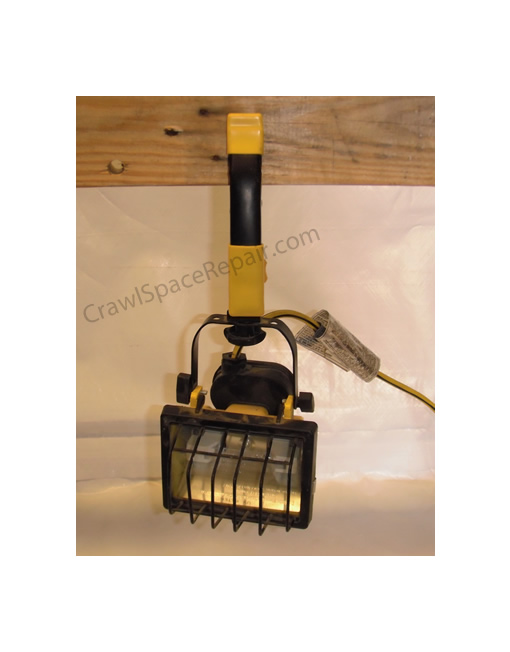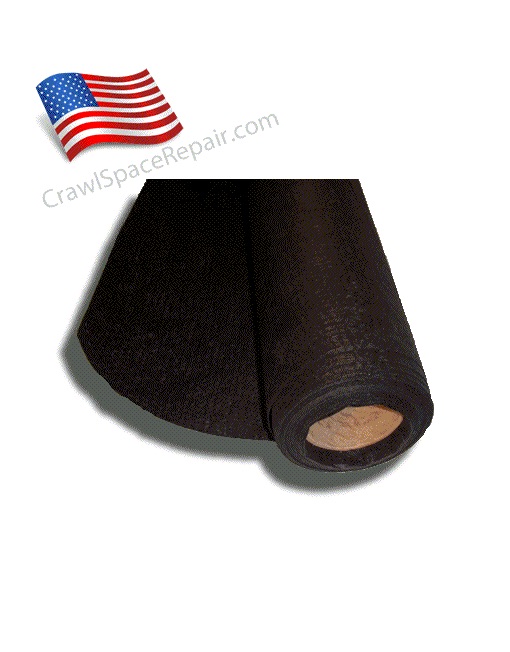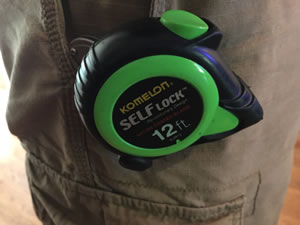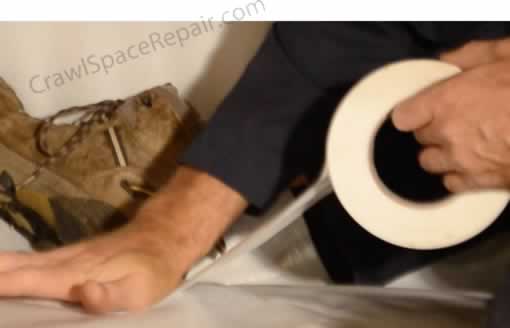DIY Crawl Space Encapsulation
Information on crawl space insulation can be found here- Crawl Space Insulation
Here is a straight forward step by step guide to installing a quality crawl space vapor barrier in your home. These are broad guidelines for you to follow that will apply to all crawl spaces. If you need additional guidance for more specific problems please contact us 877-379-7658. In the example below, we'll be using a 12 mil crawl space vapor barrier.
Step 1- Assess your crawl space
Before you do any work in your crawl space you should assess all areas, conditions and problems. This will help you later to know exactly what your up against.
Step 2- Lighting

You may not have thought that installing lighting in your crawl space would ever be a benefit, but if you want to solve your crawl space problems then proper lighting will be a useful aid in your efforts. Depending on the current conditions of your crawl space, I would suggest you first install temporary lighting and then wire in a permanent solution once all moisture and water problems are resolved. Here is a video about a crawl space work light you might find useful- Crawl Space Light
Step 3- Clean out and prep work

Remove everything that is not dirt or attached to the house. Most often crawl spaces are the dumping ground for building and remodeling debris, all of it must be removed to avoid problems with odor, mold and or punctures. No matter how strong the crawl space vapor barrier is, there is a possibility of punctures of sharp objects like crushed rocks, broken concrete and metal debris is not removed. IF it can not be removed or is far to large or numerous to remove you can use a protective underlayment like the Felt 550™ to prevent damage to your investment.
Step 4- Measure your crawl space

You can guess at what you need to save time, but when it comes time to spend your money you will need to be accurate. To get a proper picture of what you will need for water control, a crawl space vapor barrier and a proper crawl space dehumidifier will be needed to start. You will need the following information.
- the length of ALL your foundation walls
- the height of ALL your foundation walls
- the location of the lowest point in your crawl space
- the location of your access to the crawl space
- size of your access
- do you have any water problems? have you ever seen ANY amount of water standing in the crawl space? are there stains on the foundation walls?
- does your home have air conditioning?
- does your crawl space currently have foundation vents to the outdoors?
Take this information and make a drawing of your crawl space. This drawing will aid in the planning and the execution of your crawl space project.
Step 5- Product selection
Resist the urge to make Step 5 the first step. Here's why; you should not make the crawl space fit the products, you should select the products that fix the crawl space. Certainly cost is a concern for most, but if you select a crawl space vapor barrier on price alone you will get what you pay for. Or worse, you will pay to much for a cheap product thinking it is better because a reseller calls an 8 mil thick vapor barrier a 20 Mil thick vapor barrier so their price looks CHEAP. Our recommendation assumes the reader: wants their work to last as long as possible, product quality is a concern and results are a must. Find the recommendation at this link- Vapor Barrier Selection From here it's time to get grizzly and fix that mess under your home. The final 5 installation steps are as follows...
DIY Crawl Space Liner Installation
Step 6- Tools
I am sure you already know, but I am going to say it anyway; it is so much easier, faster and cheaper to do ANY project when you have the right tools. Here are some tools to consider:
Step 7- Foundation walls
This is the area that has the most fluctuation in install procedures from one company to another. I will tell you how we do it and then you will have it to compare to the many other variations. Some of the other procedures seem faster and better on paper, but do not pan out in practice. My example crawl space is going to be a rectangle, 30 feet wide 60 feet long and 4 feet 3 inches high and we will be installing 12 Mil GuardianLiner™ In the procedure we recommend, you will install the walls first, but you must figure how your floors will lay before you can start. Facts:
- In our example our crawl space is 30' wide.
- The GuardianLiner™ is 13'4" wide.
- For best results, floor seam should overlap 10-12"
- To cover the floor width we will need 2 pieces of GuardianLiner™ with the width of 13'4" side by side
- 13'4 + 13'4 = 26'8" minus the 12" lap seam we can cover 25'8" of floor width with two pieces of GuardianLiner™
- We have a 30' wide crawl space, we have 25'8" of crawl space vapor barrier to lay on the floor.
- 30' minus 25'8" leaves us 4' 4" short from covering the entire width of the floor.
Here is the reason we need to know the floor layout before we start cutting the walls- Now we know how short our floor piece is from reaching all the way across the crawl space, so we can make our wall pieces longer to cover the missing floor piece. We recommend hanging the wall pieces like wallpaper, in other words, the 13'4" width will go at the top and the bottom. This will give you many smaller pieces to handle rather than one large piece. The length of the wall section will equal the wall height (minus 3" termite inspection gap)+ floor overlap + whatever the floor piece is short.
In our example we are 5'4" short so I would tell you to split it equally on both side; you will need 2'8" + 12" floor lap on each side added to the wall piece. Our wall height is 4'3", minus 3" for the termite inspection gap and we are left with; 4' wall height+ 2'8" floor piece we are short + 12" floor lap= 7'8" wall lengths. Wall seams (between each wall piece) should be 4" to 6" over lap. This will not come out to an even number, but here is how you figure how many wall pieces you need.
Our crawl space is 30' wide and 60' long making our perimeter 180' around the crawl space. To figure the proper amount of crawl space vapor barrier to cut we will have to divid (13'4" minus 4" overlap) 13' by 180' which comes to 13.8 wall pieces. You will cut 14 wall sections 7'8" and since we left 4" for the wall over lap and there is extra you can make the wall laps wider than 4" (you have the extra material in the 14 pieces).
Make ALL your cuts outside and then bring them into the crawl space, it is much easier, faster and cleaner. Before you cut, consider this- If the floor is short by 2'8" on the sides you should make the length short by the same amount at both ends. Here's why, in a crawl space that is flat and the wall height is the same all around you can make all the wall pieces the same length (here 7'8") and not have to adjust at both ends with a shorter piece.
It does not matter what piece it comes from, the floor or the walls because you are sealing it with the seam tape. One other reason, the farther your tape seams are from the foundation wall the easier it is to tape. If you are taping 2'8" away from the foundation wall all the way around the crawl space it will be way easier for you and you can do a much better job sealing the seams. So in this example your floor pieces would be 54'6" long. That will leave a 2'8" gap on the ends that will match the 2'8" gap on the sides.
The other thing to consider before you cut is to cut both floor pieces first, then make the wall pieces from what is left. In our example, we want two floor pieces 54'6" long and each of them from one piece (no splices). This job will take three 13'4"x75' long rolls of GuardianLiner™ to complete, if done correctly. If you cut ALL the wall pieces first one of your floor halves will be in at least 2 pieces, not one. Here is how that happens, 14 wall sections 7'8" long comes to 108' of material.
You will get 9 wall pieces from one full roll and then you will need 5 wall pieces from another roll. Those 5 pieces will take 38'4" from the 75' roll. That roll is now 36'6" long and you need 54'6", so you will have to take the 20' from the other floor piece (75' long minus 54'6" = 20'4") and tape it to the end of the other floor piece to get the length right. It is not a big deal as far as function goes because you will tape the two together, but when it happens you will tell yourself you should have cut the floor pieces first.
Brush (not wire brush, just broom) the foundation wall at the top where you will be attaching the crawl space vapor barrier to remove loose dirt and spider webs. Install the Foundation Seal Tape™ along the perimeter of the foundation wall. You may need to use Poly Caulk if the foundation is very wet. Once the wall pieces are stuck to the Foundation Seal Tape and the floors have been taped to the walls you can install the Foundation Pins™. At the bottom of this article you will find videos for both Foundation Seal Tape™ and Foundation Pins™ installation.
Step 8- Floor
There is not much left to explain here. One advantage to splitting the floor width shortage of the crawl space vapor barrier to equal amounts on each side is your center seam will meet at your row of support columns so cutting around them will be much easier. Keep your vapor barrier pieces square to the crawl space and taking your shoes off will lighten the clean up work later. Here is a video on how to install a crawl space vapor barrier so you can see it in real time.
Step 9- Taping

The Waterproof Seam Tape™ is designed to work with the above mentioned crawl space vapor barriers and will not come loose when it comes in contact with water, this is very important because many "crawl space tapes" do just that. Take your time and remember to keep the crawl space vapor barrier square to the crawl space when you are taping
Step 10- Conditioning the air

A conditioned crawl space can be accomplished a few different ways, the important part is to DO IT. Conditioning a crawl space is THE reason the crawl space needed to be encapsulated, so don't skip this part to save money. Would you buy a pool and not fill it with water because it was not included in the price or it would make the cost of the pool less expensive if you left it out? Conditioning can be done with a quality crawl space dehumidifier or by using your existing air conditioning unit. Both options have their strengths. The best way to know which is best for your home is to get a moisture management plan for your crawl space. You can read more about a conditioned crawl space here- Conditioned Crawl Space
Install Videos